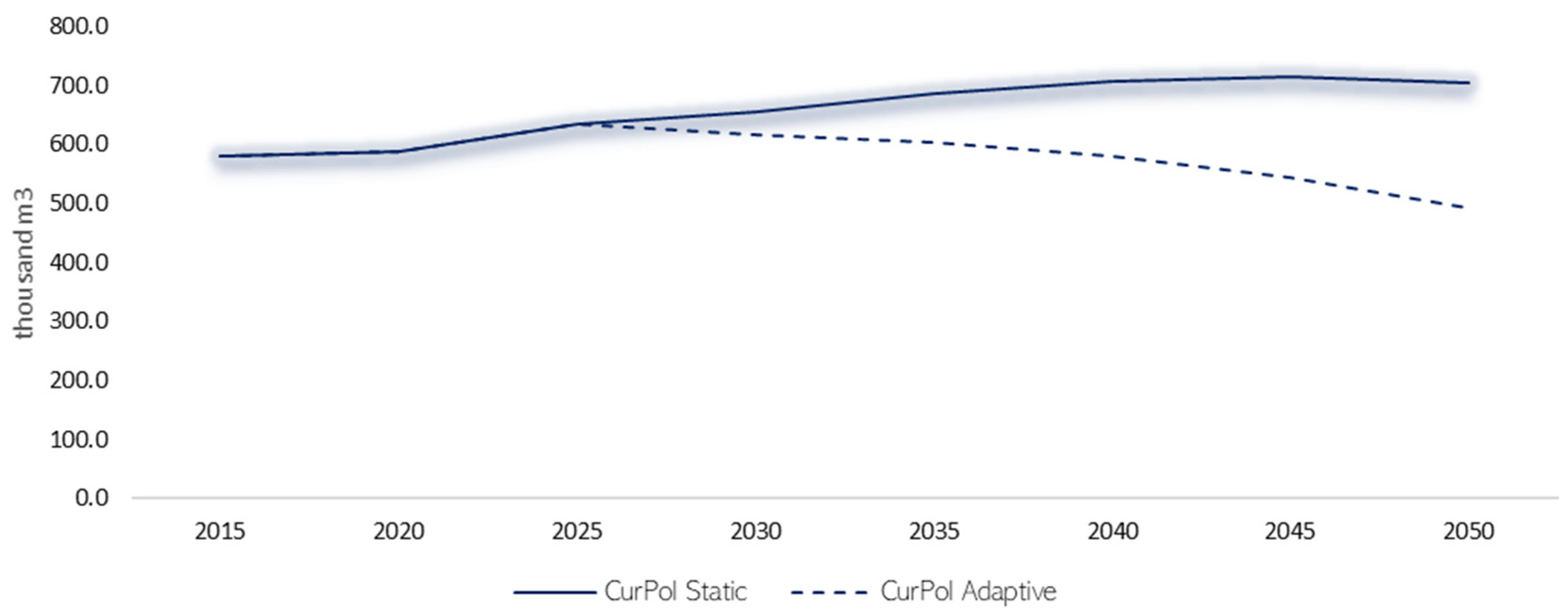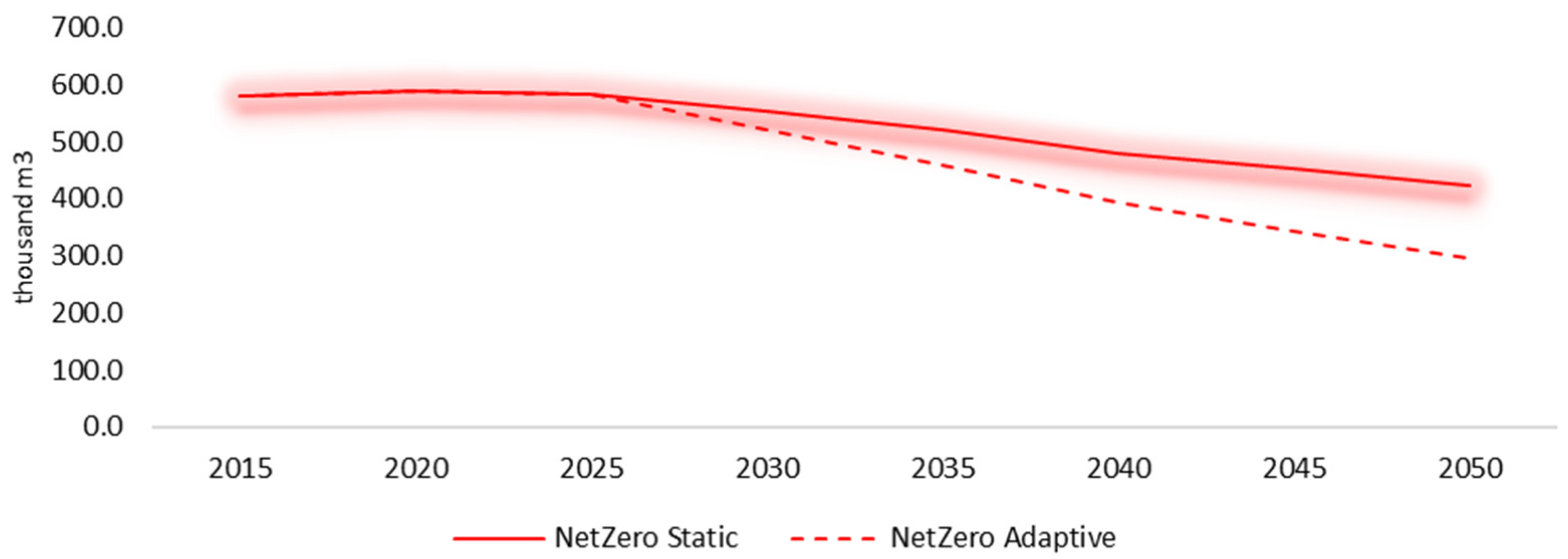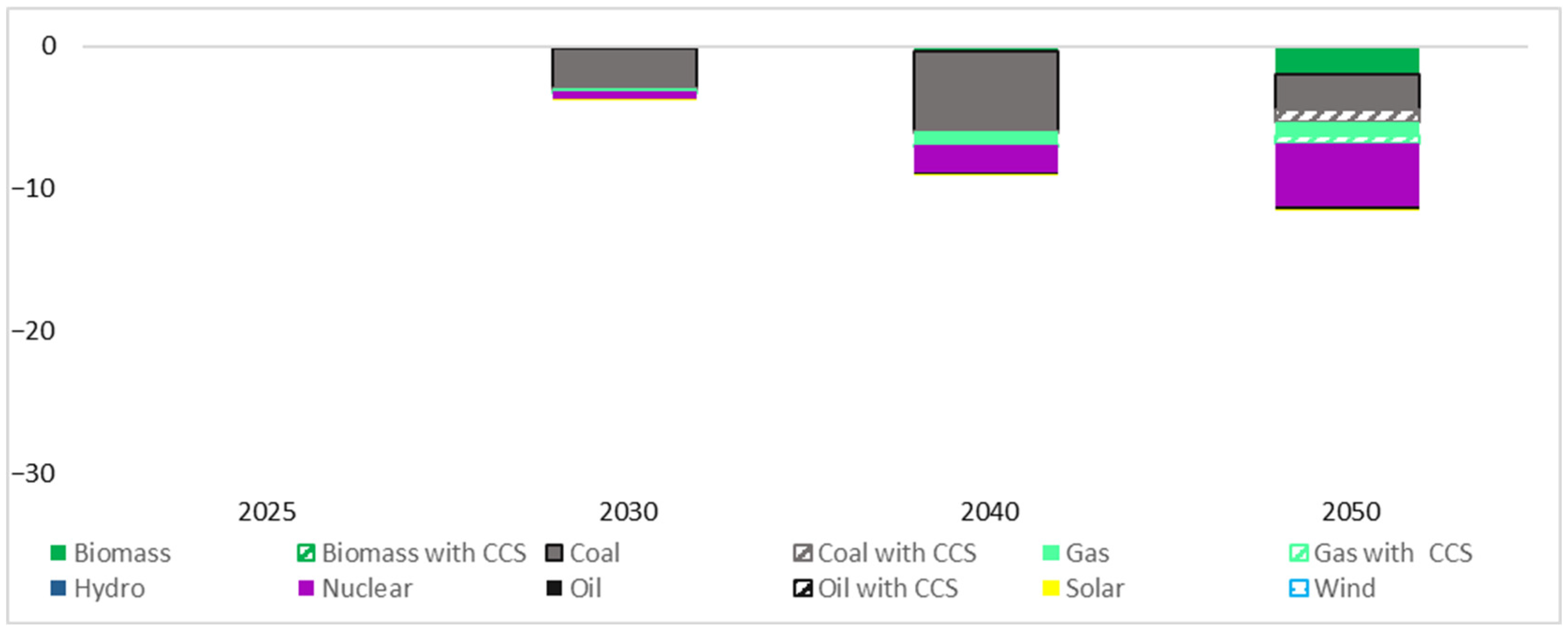How Climate Ambition and Technology Choices Shape Water Use in the Power Generation Sector
Abstract
1. Introduction
2. Materials and Methods
2.1. Tools
2.2. Representation of Water Demand in PROMETHEUS
- : Electricity generation (EJ) from generation technology i, in region r and year t and cooling technology j
- : Water withdrawal or consumption coefficient for that technology/cooling combination
2.3. Scenarios
- Net-Zero (NZ): This scenario includes the full implementation of the Nationally Determined Contributions (NDCs) by 2030 and the Long-Term Low-Emission Development Strategies (LT-LEDS), including the national net-zero pledges by mid-century. The net-zero scenario (NZ) assumes that all countries and regions will implement their long-term targets as officially announced in their LT-LEDS.
- Static Cooling (S): Assumes no change in the distribution of cooling technologies over time. The shares of once-through, recirculating, dry, and seawater cooling systems remain fixed at their 2015 levels, based on the ‘Base year’ values reported by [20] over the whole study period.
- Adaptive Cooling (A): Assumes a gradual shift towards less-water-intensive cooling technologies. Starting from the 2015 ‘Base year’ values, the shares of cooling technologies evolve linearly to the ‘Future’ values from [20] by 2050, reflecting potential adaptation to water scarcity and policy incentives.
3. Results
3.1. Static Case
3.1.1. Does Electricity Production Growth Drive Water Pressure?
3.1.2. How the Power Generation Mix Influences Water Consumption and Withdrawals?
3.2. The Adaptive Case
3.2.1. To What Extent Can Adaptive Cooling Strategies Reduce Water Demand in the Power Sector Under Current Policies?
3.2.2. What Is the Impact of the Adaptive Case in a Net-Zero World?
4. Discussion
5. Conclusions
Author Contributions
Funding
Data Availability Statement
Conflicts of Interest
References
- Mevono Mvogo, D. Water Under the Paris Agreement: An Unexploited Potential? Liverp. Law Rev. 2024, 45, 409–424. [Google Scholar] [CrossRef]
- Ke, J.; Khanna, N.; Zhou, N. Analysis of water–energy nexus and trends in support of the sustainable development goals: A study using longitudinal water–energy use data. J. Clean. Prod. 2022, 371, 133448. [Google Scholar] [CrossRef]
- IEA. Clean Energy Can Help to Ease the Water Crisis; IEA: Paris, France, 2023; Available online: https://www.iea.org/commentaries/clean-energy-can-help-to-ease-the-water-crisis (accessed on 20 March 2025).
- International Renewable Energy Agency. IRENA Renewable Energy in the Water, Energy & Food Nexus. 2015. Available online: https://www.irena.org/-/media/Files/IRENA/Agency/Publication/2015/IRENA_Water_Energy_Food_Nexus_2015.pdf (accessed on 20 March 2025).
- UNDP-SIWI Water Governance Facility. Water Interactions for Consideration in NDC Enhancement and Implementation; SIWI: Stockholm, Switzerland, 2020. [Google Scholar]
- Luo, T.; Krishnan, D.; Sen, S. Parched Power: Water Demands, Risks, and Opportunities for India’s Power Sector; World Resources Institute: Washington, DC, USA, 2018. [Google Scholar]
- World Bank. Technical Assessment: Yellow River Basin Ecological Protection and Environmental Pollution Control Program (P172806). 2022. Available online: https://documents1.worldbank.org/curated/en/099045103102228376/pdf/Final0Technica0l0Program000P172806.pdf (accessed on 24 August 2025).
- Zhang, F.; Jin, G.; Liu, G. Evaluation of virtual water trade in the Yellow River Delta, China. Sci. Total Environ. 2021, 784, 147285. [Google Scholar] [CrossRef] [PubMed]
- Zohrabian, A.; Sanders, K.T. Assessing the impact of drought on the emissions-and water-intensity of California’s transitioning power sector. Energy Policy 2018, 123, 461–470. [Google Scholar] [CrossRef]
- Nouri, N.; Balali, F.; Nasiri, A.; Seifoddini, H.; Otieno, W. Water withdrawal and consumption reduction for electrical energy generation systems. Appl. Energy 2019, 248, 196–206. [Google Scholar] [CrossRef]
- Shaikh, M.A.; Kucukvar, M.; Onat, N.C.; Kirkil, G. A framework for water and carbon footprint analysis of national electricity production scenarios. Energy 2017, 139, 406–421. [Google Scholar] [CrossRef]
- Van Vliet, M.T.; Wiberg, D.; Leduc, S.; Riahi, K. Power-generation system vulnerability and adaptation to changes in climate and water resources. Nat. Clim. Change 2016, 6, 375–380. [Google Scholar] [CrossRef]
- Larsen, M.A.D.; Drews, M. Water use in electricity generation for water-energy nexus analyses: The European case. Sci. Total Environ. 2019, 651, 2044–2058. [Google Scholar] [CrossRef]
- Hejazi, M.I.; Edmonds, J.; Clarke, L.; Kyle, P.; Davies, E.; Chaturvedi, V.; Wise, M.; Patel, P.; Eom, J.; Calvin, K. Integrated assessment of global water scarcity over the 21st century under multiple climate change mitigation policies. Hydrol. Earth Syst. Sci. 2014, 18, 2859–2883. [Google Scholar] [CrossRef]
- Fricko, O.; Parkinson, S.C.; Johnson, N.; Strubegger, M.; van Vliet, M.T.H.; Riahi, K. Energy sector water use implications of a 2 °C climate policy. Environ. Res. Lett. 2016, 11, 034011. [Google Scholar] [CrossRef]
- Jin, Y.; Behrens, P.; Tukker, A.; Scherer, L. Water use of electricity technologies: A global meta-analysis. Renew. Sustain. Energy Rev. 2019, 115, 109391. [Google Scholar] [CrossRef]
- Guivarch, C.; Le Gallic, T.; Bauer, N.; Fragkos, P.; Huppmann, D.; Jaxa-Rozen, M.; Keppo, I.; Kriegler, E.; Krisztin, T.; Marangoni, G.; et al. Using large ensembles of climate change mitigation scenarios for robust insights. Nat. Clim. Chang. 2022, 12, 428–435. [Google Scholar] [CrossRef]
- Fragkos, P.; Kouvaritakis, N.; Capros, P. Incorporating Uncertainty into World Energy Modelling: The PROMETHEUS Model. Environ. Model. Assess. 2015, 20, 549–569. [Google Scholar] [CrossRef]
- Macknick, J.; Newmark, R.; Heath, G.; Hallett, K.C. A Review of Operational Water Consumption and Withdrawal Factors for Electricity Generating Technologies; Prepared Under Task No. DOCC.1005; National Renewable Energy Laboratory: Golden, CO, USA, 2011. Available online: https://docs.nrel.gov/docs/fy11osti/50900.pdf (accessed on 30 July 2025).
- Mouratiadou, I.; Biewald, A.; Pehl, M.; Bonsch, M.; Baumstark, L.; Klein, D.; Popp, A.; Luderer, G.; Kriegler, E. The impact of climate change mitigation on water demand for energy and food: An integrated analysis based on the Shared Socio-economic Pathways. Environ. Sci. Policy 2016, 64, 48–58. [Google Scholar] [CrossRef]
- Kyle, P.G.; Davies, E.G.; Dooley, J.J.; Smith, S.J.; Clarke, L.; Edmonds, J.A.; Hejazi, M.I. Influence of climate change mitigation technology on global demands of water for electricity generation. Int. J. Greenh. Gas Control 2013, 13, 112–123. [Google Scholar] [CrossRef]
- IAMCOMPACT. Expanding Integrated Assessment Modelling: Comprehensive and Comprehensible Science for Sustainable, Co-created Climate Action. 2025. Available online: https://www.i2am-paris.eu/feasibility/landing (accessed on 12 June 2025).
- PARISREINFORCE. I2AM PARIS: Integrating Integrated Assessment Modelling in Support of the Paris Agreement. 2020. Available online: https://www.i2am-paris.eu/ (accessed on 24 February 2025).
- Eurostat. EUROPOP2019—Population Projections at Regional Level (2019–2100) (Short-Term Update 28 September 2022) [Data Set]. 2022. Available online: https://ec.europa.eu/eurostat/databrowser/explore/all/popul?lang=en&subtheme=proj.proj_19r (accessed on 30 October 2023).
- United Nations. World Population Prospects 2024: Dataset; United Nations Department of Economic and Social Affairs, Population Division: New York, NY, USA, 2024; Available online: https://population.un.org/wpp/ (accessed on 30 January 2025).
- US Bureau of Economic Analysis. Gross Domestic Product, Third Quarter 2024 (Second Estimate) and Corporate Profits (Preliminary). 2024. Available online: https://www.bea.gov/data/gdp/gross-domestic-product (accessed on 5 August 2025).
- International Monetary Fund. World Economic Outlook, 2023; Navigating Global Divergences: Washington, DC, USA, 2023; Available online: https://www.imf.org/en/Publications/WEO/Issues/2023/10/10/world-economic-outlook-october-2023 (accessed on 8 April 2024).
- IEA. World Energy Outlook 2024; IEA: Paris, France, 2024; Available online: https://www.iea.org/reports/world-energy-outlook-2024 (accessed on 24 August 2025).
- World Bank. Fossil Fuel Energy Consumption (% of Total). 2024. Available online: https://data.worldbank.org/indicator/EG.USE.COMM.FO.ZS (accessed on 5 August 2025).
- Wallis, P.J.; Ward, M.B.; Pittock, J.; Hussey, K.; Bamsey, H.; Denis, A.; Kenway, S.J.; King, C.W.; Mushtaq, S.; Retamal, M.L.; et al. The water impacts of climate change mitigation measures. Clim. Change 2014, 125, 209–220. [Google Scholar] [CrossRef]
- Sanders, K.T. Critical review: Uncharted waters? The future of the electricity-water nexus. Environ. Sci. Technol. 2015, 49, 51–66. [Google Scholar] [CrossRef]
- Licandeo, F.; Flores, F.; Feijoo, F. Assessing the impacts of economy-wide emissions policies in the water, energy, and land systems considering water scarcity scenarios. Appl. Energy 2023, 342, 121115. [Google Scholar] [CrossRef]
- United Nations. (n.d.). Goal 13: Take Urgent Action to Combat Climate Change and Its Impacts. United Nations Sustainable Development Goals. Available online: https://sdgs.un.org/goals/goal13 (accessed on 5 August 2025).
- United Nations. Goal 6: Ensure Availability and Sustainable Management of Water and Sanitation for All. United Nations Sustainable Development Goals. Available online: https://sdgs.un.org/goals/goal6 (accessed on 5 August 2025).
- Rosa, L.; Reimer, J.A.; Went, M.S.; D’Odorico, P. Hydrological limits to carbon capture and storage. Nat. Sustain. 2020, 3, 658–666. [Google Scholar] [CrossRef]
- Hoegh-Guldberg, O.; Jacob, D.M.; Taylor, M.; Bindi, S.; Brown, I.; Camilloni, A.; Diedhiou, R.; Djalante, K.L.; Ebi, F.; Engelbrecht, J.; et al. Impacts of 1.5 °C Global Warming on Natural and Human Systems. In Global Warming of 1.5 °C. An IPCC Special Report on the Impacts of Global Warming of 1.5 °C Above Pre-Industrial Levels and Related Global Greenhouse Gas Emission Pathways, in the Context of Strengthening the Global Response to the Threat of Climate Change, Sustainable Development, and Efforts to Eradicate Poverty; Masson-Delmotte, V., Zhai, P., Pörtner, H.-O., Roberts, D., Skea, J., Shukla, P.R., Pirani, A., Moufouma-Okia, W., Péan, C., Pidcock, R., et al., Eds.; 2018; in press; Available online: https://www.ipcc.ch/site/assets/uploads/sites/2/2019/05/SR15_Chapter3_SM_V6_for_web.pdf (accessed on 8 August 2025).
- Statista. Water Withdrawals per Capita Worldwide as of 2021, by Select Country (in Cubic Meters per Inhabitant). 2021. Available online: https://www.statista.com/statistics/263156/water-consumption-in-selected-countries/ (accessed on 12 June 2025).
- Khan, Z.; Linares, P.; García-González, J. Integrating water and energy models for policy driven applications. A review of contemporary work and recommendations for future developments. Renew. Sustain. Energy Rev. 2017, 67, 1123–1138. [Google Scholar] [CrossRef]
- Eldardiry, H.; Habib, E. Carbon capture and sequestration in power generation: Review of impacts and opportunities for water sustainability. Energy Sustain. Soc. 2018, 8, 6. [Google Scholar] [CrossRef]
- IPCC. Summary for Policymakers. In Climate Change 2023: Synthesis Report Contribution of Working Groups, I; II; III to the Sixth Assessment Report of the Intergovernmental Panel on Climate Change; Core Writing Team, Lee, H., Romero, J., Eds.; IPCC: Geneva, Switzerland, 2023; pp. 1–34. [Google Scholar] [CrossRef]
- IEA. Water-Energy Nexus; IEA: Paris, France, 2017; Available online: https://www.iea.org/reports/water-energy-nexus (accessed on 24 August 2025).
- Wu, H.; Zeng, X.; Zhang, L.; Liu, X.; Jiang, S.; Dong, Z.; Meng, X.; Wang, Q. Water-energy nexus embedded in coal supply chain of a coal-based city, China. Resour. Policy 2023, 85, 103812. [Google Scholar] [CrossRef]
- Gao, X.; Zhao, Y.; Lu, S.; Chen, Q.; An, T.; Han, X.; Zhuo, L. Impact of coal power production on sustainable water resources management in the coal-fired power energy bases of Northern China. Appl. Energy 2019, 250, 821–833. [Google Scholar] [CrossRef]
- World Bank. Climate Investment Opportunities in India’s Cooling Sector; International Bank for Reconstruction and Development/The World Bank: Washington, DC, USA, 2022; Available online: https://documents1.worldbank.org/curated/en/099920011222212474/pdf/P15743300f4cc10380b9f6051f8e7ed1147.pdf (accessed on 12 June 2025).
- Mikulčić, H.; Baleta, J.; Klemeš, J.J.; Wang, X. Energy transition and the role of system integration of the energy, water and environmental systems. J. Clean. Prod. 2021, 292, 126027. [Google Scholar] [CrossRef]
- Lilliestam, J.; Thonig, R.; Späth, L.; Caldés, N.; Lechón, Y.; Del Río, P.; Kiefer, C.; Escribano, G.; Touza, L.L. Policy pathways for the energy transition in Europe and selected European countries. In Update September 2019. MUSTEC Project Deliverable; SCCER JA IDEA, ETH Zürich: Zürich, Switzerland, 2019; Volume 7, Available online: https://media.realinstitutoelcano.org/wp-content/uploads/2021/11/lilliestam-etal-2019-policy-pathways-for-the-energy-transition-in-europe-and-selected-european-countries.pdf (accessed on 24 August 2025).
- Allen, M.R.; Dube, O.P.; Solecki, W.; Aragón-Durand, F.; Cramer, W.; Humphreys, S.; Kainuma, M.; Kala, J.; Mahowald, N.; Mulugetta, Y.; et al. Framing and Context. In Global Warming of 1.5 °C. An IPCC Special Report on the Impacts of Global Warming of 1.5 °C Above Pre-Industrial Levels and Related Global Greenhouse Gas Emission Pathways, in the Context of Strengthening the Global Response to the Threat of Climate Change, Sustainable Development, and Efforts to Eradicate Poverty; Masson-Delmotte, V., Zhai, P., Pörtner, H.-O., Roberts, D., Skea, J., Shukla, P.R., Pirani, A., Moufouma-Okia, W., Péan, C., Pidcock, R., et al., Eds.; Cambridge University Press: Cambridge, UK; New York, NY, USA, 2018; pp. 49–92. [Google Scholar] [CrossRef]
- Parkinson, S. Guiding urban water management towards 1.5 °C. npj Clean Water 2021, 4, 34. [Google Scholar] [CrossRef]
- Stillwell, A.S.; Webber, M.E. Novel methodology for evaluating economic feasibility of low-water cooling technology retrofits at power plants. Water Policy 2013, 15, 292–308. [Google Scholar] [CrossRef]










| Scenario Name | Climate Policy Ambition | Cooling Technology Assumptions | Description |
|---|---|---|---|
| CP-Static | Current policies | Static | Represents the continuation of current climate policies without new mitigation or adaptation efforts. |
| CP-Adaptive | Current Policies | Adaptive | Reflects the continuation of current climate policies, but with a technological response to water stress. |
| NZ-Static | Net-zero | Static | Reflects ambitious climate policies without adaptation in cooling systems. |
| NZ-Adaptive | Net-zero | Adaptive | This scenario assumes strong climate ambition and the uptake of water-efficient cooling technologies. |
Disclaimer/Publisher’s Note: The statements, opinions and data contained in all publications are solely those of the individual author(s) and contributor(s) and not of MDPI and/or the editor(s). MDPI and/or the editor(s) disclaim responsibility for any injury to people or property resulting from any ideas, methods, instructions or products referred to in the content. |
© 2025 by the authors. Licensee MDPI, Basel, Switzerland. This article is an open access article distributed under the terms and conditions of the Creative Commons Attribution (CC BY) license (https://creativecommons.org/licenses/by/4.0/).
Share and Cite
Fragkos, P.; Zisarou, E.; Govorukha, K. How Climate Ambition and Technology Choices Shape Water Use in the Power Generation Sector. Climate 2025, 13, 174. https://doi.org/10.3390/cli13090174
Fragkos P, Zisarou E, Govorukha K. How Climate Ambition and Technology Choices Shape Water Use in the Power Generation Sector. Climate. 2025; 13(9):174. https://doi.org/10.3390/cli13090174
Chicago/Turabian StyleFragkos, Panagiotis, Eleftheria Zisarou, and Kristina Govorukha. 2025. "How Climate Ambition and Technology Choices Shape Water Use in the Power Generation Sector" Climate 13, no. 9: 174. https://doi.org/10.3390/cli13090174
APA StyleFragkos, P., Zisarou, E., & Govorukha, K. (2025). How Climate Ambition and Technology Choices Shape Water Use in the Power Generation Sector. Climate, 13(9), 174. https://doi.org/10.3390/cli13090174







